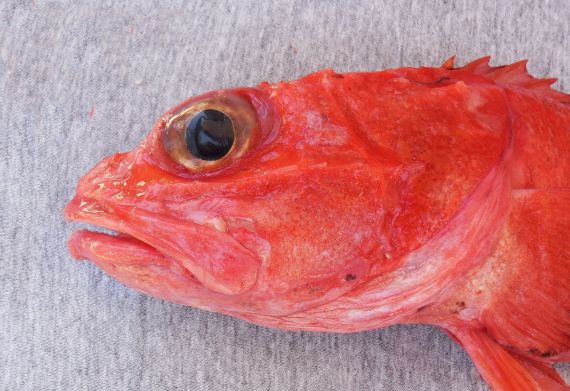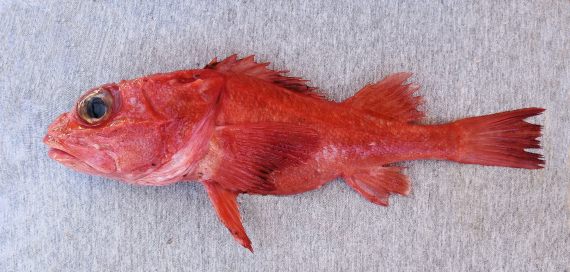Shortspine Thornyhead, Sebastolobus alascanus
 Shortspine Thornyhead, Sebastolobus alascanus. Fish provided by the commercial fishermen of the greater San Diego area, San Diego, California, October 2014. Length: 36 cm (14 inches).
Shortspine Thornyhead, Sebastolobus alascanus. Fish provided by the commercial fishermen of the greater San Diego area, San Diego, California, October 2014. Length: 36 cm (14 inches).
The Shortspine Thornyhead, Sebastolobus alascanus, is a member of the Rockfish and Scorpionfish or Scorpaenidae Family, and is known in Mexico as chancharro alacrán. Globally, there are three species in the genus Sebastolobus, of which two are found in Mexican waters, both in the Pacific Ocean.
The Shortspine Thornyhead has an elongated body with a depth that is 24% to 28% of standard length. They have a red to orange-red coloration with white patches on their sides, back, cheeks, and spiny dorsal fin. Their gill chambers are light in color. Their dorsal fin has a dark spot posteriorly and black patches on its sides. They have a large head, cheeks with 8 to 10 strong spines, and a large terminal mouth. Their anal fin has 3 spines, the second being longer than the third, and 4 or 5 rays; their caudal fin is square; their dorsal fin has 15 to 18 spines, the third being shorter than the fourth, and 8 or 9 rays; and, their pectoral fins are strongly notched with 22 or 23 rays. They have 18 to 23 gill rakers. Their body is covered with scales.
The Shortspine Thornyhead is a demersal species that reside in a wide variety of habitats including low hard relief, boulders and muddy bottoms and are found at depths between 18 m (60 feet) and 1,525 m (5,000 feet). They reach a maximum 83 cm (2 feet 9 inches) in length, with females being larger than males. As of January 1, 2024, the International Game Fish Association world record stood at 3.74 kg (8 lbs 4 oz) with the fish caught in coastal waters off Ketchikan, Alaska in July 2015. They are found as solitary individuals and are known to lay motionless on the bottom for long periods of time. They feed on other fish and invertebrates including amphipods and shrimp. Reproduction is oviparous with eggs being released in a gelatinous egg mass that is pelagic. They have a lifespan of up to 100 years making them one of the longest living fish known. The Shortspine Thornyhead is poorly studied with very limited information available about their lifestyle and behavioral patterns including specific details on age, growth, longevity, movement patterns, diet, habitat use, and reproduction.
The Shortspine Thornyhead is a resident of Mexican waters of the Pacific but has a limited distribution being found from Magdalena Bay, Baja California Sur, northward along the central and northwest coasts of Baja.
The Thornyheads can be distinguished from other Rockfish by the spiny ridges across their cheeks. They also have 15 or 16 dorsal spines while other Rockfish have 13. The Shortspine Thornyhead is similar to and found mixed in with the Longspine Thornyhead, Sebastolobus altivelis (elongated third dorsal spine).
From a conservation perspective the Shortspine Thornyhead is currently considered to be ENDANGERED; however, they are poorly monitored and their actually population trends are unknown. They are currently an expanding component of the California commercial fishery with fish taken primarily by deep water bottom trawls and the majority being exported to Japan. In domestic markets many are sold live as they lack a swim bladder and can survive after being hauled up from the deep. They are caught occasionally by recreational anglers but the equipment needed to reach their depth make them a poor sportsfish.
